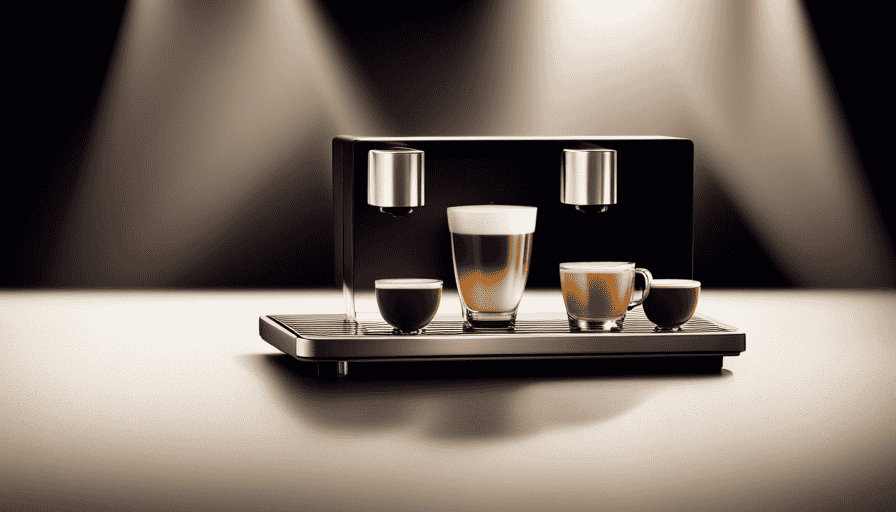Coffee Brewing Methods
The Magic Of Nespresso Machines: How They Brew Perfect Coffee

In the realm of coffee brewing, there exists a magical contraption capable of producing the perfect cup of joe with unparalleled ease. This wondrous invention, known as the Nespresso machine, is a true marvel of modern coffee technology.
Like a master magician performing a mesmerizing trick, the Nespresso machine deftly transforms humble coffee capsules into a symphony of flavors that dance upon the palate.
This article delves into the enchanting world of Nespresso machines, uncovering the secrets behind their ability to brew impeccable coffee. Through an intricate combination of science and artistry, these machines work their alchemy to produce a cup that is rich, robust, and utterly satisfying.
We begin our exploration by peering behind the curtain to unveil the inner workings of these remarkable machines. From the puncturing of the capsule to the infusion of water and coffee grounds, we unravel the brewing process step by step, uncovering the meticulous attention to detail that goes into each brew.
Moreover, we delve into the importance of regular descaling and maintenance, highlighting the vital role they play in preserving the machine’s performance and ensuring the continued excellence of the coffee it produces.
Join us on this enchanting journey as we unravel the magic of Nespresso machines, revealing the secrets that enable them to conjure the perfect cup of coffee with every delightful sip.
Key Takeaways
- Nespresso machines use a puncturing mechanism and high pressure to extract espresso from the capsule, ensuring a burst of flavor.
- The VertuoLine machines utilize a unique extraction process with centrifugal force to create larger coffees with a thicker layer of crema.
- Nespresso machines are designed for convenience, automatically ejecting used pods and offering easy cleanup.
- Regular descaling is recommended to maintain the machine’s performance and ensure the best taste of coffee.
How Nespresso Machines Work
Nespresso machines operate by puncturing the capsule, pumping water from the tank, heating the water, injecting it into the capsule under high pressure, and utilizing a filter to prevent coffee grounds from entering the cup, as previously discussed.
There are two main types of Nespresso machines: the Original Line machines and the VertuoLine machines. The Original Line machines puncture the capsule three times on the top side and pump the correct amount of water from the water tank to the capsule. They also feature a heating element to reach the perfect brewing temperature.
On the other hand, the VertuoLine machines read the barcode on each capsule to optimize brewing parameters and use a different extraction process with dome-shaped pods and centrifugal force.
One of the benefits of using Nespresso capsules is their hermetically sealed aluminum construction, which preserves the freshness and aroma of the coffee. Additionally, Nespresso machines are designed to be easy to use and provide a convenient and consistent brewing experience.
Brewing Process
The brewing process of Nespresso machines involves puncturing a capsule multiple times, pumping water from the water tank, heating the water using a heating element, and infusing the water with ground coffee beans under high pressure to extract espresso.
The brewing temperature plays a crucial role in determining the flavor of the coffee. Nespresso machines ensure the water is heated to the perfect brewing temperature, which enhances the extraction of flavors from the coffee beans.
In comparison to traditional espresso machines, Nespresso machines offer a convenient and simplified brewing process. While traditional espresso machines require manual grinding of coffee beans and precise control of brewing parameters, Nespresso machines automate these steps, ensuring consistent results with every cup.
However, it should be noted that Nespresso espresso may not possess the same depth and complexity of flavor as drinks made with freshly ground beans and a proper espresso machine.
Descaling and Maintenance
Descaling and maintenance of Nespresso machines is an essential aspect of ensuring their longevity and optimal performance. Regular descaling is of utmost importance as it helps remove mineral build-up that can affect the machine’s pressure, temperature, and ultimately, the taste of the coffee.
Nespresso recommends descaling their machines every 3 months or after every 300 capsules. By descaling regularly, users can maintain the efficiency and functionality of their machines, ensuring a consistent and high-quality brewing experience.
When it comes to descaling, using a universal descaler is highly beneficial. A universal descaler is specifically designed to remove limescale and mineral deposits from various coffee machines, including Nespresso machines. It effectively eliminates any residue that may accumulate over time, allowing the machine to function optimally and prolonging its lifespan.
By incorporating regular descaling and utilizing a universal descaler, Nespresso machine owners can enjoy their favorite coffee without compromising on taste or performance.
Frequently Asked Questions
What is the difference between Nespresso Original Line machines and VertuoLine machines?
The main difference between Nespresso Original Line machines and VertuoLine machines lies in their brewing methods.
Original Line machines puncture the capsule three times, pump water into the capsule, heat it, and then pump it under high pressure to extract espresso.
VertuoLine machines, on the other hand, use a different extraction process with dome-shaped pods and centrifugal force. They read the barcode on each capsule to optimize brewing parameters and produce larger coffees with a thicker layer of crema.
Can Nespresso machines make regular coffee or just espresso?
Nespresso machines have the capability to produce both regular coffee and espresso. While espresso is the primary focus of Nespresso machines, they can also be used to make regular coffee. However, the flavor profile and brewing process may differ between the two.
Nespresso machines are designed to extract the maximum flavor and aroma from the coffee beans, resulting in a rich and flavorful cup of coffee or espresso. Whether regular coffee or espresso is better for Nespresso machines depends on individual preferences and desired taste.
Additionally, Nespresso machines are primarily designed for coffee and espresso, but they can also produce other beverages such as Americano by adding hot water to espresso shots.
How often should a Nespresso machine be descaled?
Descaling a Nespresso machine is an important maintenance task that should be performed regularly to ensure optimal performance and taste.
It is recommended to descale the machine every 3 months or after every 300 capsules.
Descaling involves using Nespresso descaling liquid or a universal descaler to remove mineral build-up that can affect the machine’s pressure, temperature, and taste of coffee.
Proper descaling helps maintain the machine’s efficiency, extends its lifespan, and ensures the best quality coffee extraction.
What materials are Nespresso capsules made of?
Nespresso capsules are made of hermetically sealed aluminum, which is considered superior to plastic capsules used by other brands like Keurig. This choice of material has several benefits in terms of sustainability and environmental impact.
Aluminum is highly recyclable, and Nespresso has a dedicated recycling program to collect and recycle used capsules. The use of aluminum also helps to preserve the aroma and freshness of the coffee, ensuring a high-quality brewing experience. Additionally, the hermetic seal of the capsules helps to prevent oxygen and moisture from degrading the coffee, further enhancing its sustainability.
What is the optimal brewing temperature for coffee made with a Nespresso machine?
The optimal brewing temperature for coffee made with a Nespresso machine varies depending on the level of roast. Generally, for a medium roast, the recommended brewing temperature is around 195-205°F (90-96°C).
However, it is important to note that different Nespresso machine models may have variations in their temperature settings. Some of the best Nespresso machine models, such as the Nespresso Creatista Plus and the Nespresso Lattissima Pro, offer customizable brewing temperatures, allowing users to achieve their desired taste profiles.
Noah, the Editor-in-Chief at Cappuccino Oracle, plays a pivotal role in shaping the voice and vision of our renowned platform. With an unwavering passion for coffee, coffee alternatives, and tea, Noah leads Cappuccino Oracle towards new horizons in the realm of coffee journalism.
Beyond his professional responsibilities, Noah serves as a mentor and guiding force for his team. His dedication to journalistic excellence and genuine love for coffee, coffee alternatives, and tea continue to inspire and motivate the Cappuccino Oracle family. In the ever-evolving world of these beverages, Noah’s leadership ensures that our platform remains at the forefront, delivering enlightening and enjoyable content to our readers worldwide.
Coffee Brewing Methods
What Is Coffee Powder? A Guide To Instant Coffee And Its Benefits

Instant coffee, also referred to as coffee powder, offers a quick and convenient solution for coffee lovers to savor their preferred drink. Its ease of preparation has made it a household essential for numerous coffee aficionados.
But what exactly is coffee powder and how is it made?
Coffee powder is made by roasting coffee beans, grinding them, brewing the coffee, and then removing the water to create a dissolvable powder. This process ensures that all the flavors and aromas of the coffee beans are captured in the powder, allowing for a rich and flavorful cup of coffee.

One interesting statistic to note is that coffee powder and ground coffee are not the same. Instant coffee has already undergone the entire coffee-making process, making it different from ground coffee.
In addition to its convenience, coffee powder also provides the same nutrients as a standard cup of coffee. However, it is important to consume it in moderation as it contains caffeine. Reading nutrition labels and checking caffeine quantities is essential to avoid unintentional overdosing.
In this article, we will delve deeper into the world of coffee powder, exploring its production process, caffeine content, and safety considerations. So grab a cup of coffee, sit back, and let’s explore the wonders of coffee powder together.
Key Takeaways
- Coffee powder, also known as instant coffee, is a convenient way to enjoy coffee.
- It is important to consume coffee powder in moderation due to its caffeine content.
- Coffee powder provides the same nutrients as a standard cup of coffee.
- Coffee powder production has environmental impacts, but efforts are being made to reduce them through sustainable practices and technologies.
What is it?
Coffee powder, also known as instant coffee, is a soluble form of coffee made by roasting, grinding, brewing, and dehydrating coffee beans. This process results in a dissolvable powder that can be consumed as a beverage or used in cooking.
There are different types of coffee powders available, with varying flavors and strengths to suit individual preferences. One of the main advantages of coffee powder is its convenience and ease of use. It can be quickly dissolved in hot water, eliminating the need for brewing equipment or waiting for a pot of coffee to brew.
Additionally, coffee powder offers several health benefits. It contains antioxidants that help protect cells from damage, and it has been associated with a reduced risk of various diseases, including type 2 diabetes, Parkinson’s disease, and liver cancer. However, it is important to consume coffee powder in moderation, as it can also have negative effects on sleep, anxiety, and digestive health.
How it’s Made
To produce coffee powder, coffee beans are first roasted, then ground, brewed, and finally dehydrated through either spray-drying or freeze-drying methods.
-
Spray-drying involves spraying a liquid coffee extract into a hot chamber, where the water evaporates, leaving behind dried coffee particles.
-
Freeze-drying, on the other hand, involves freezing the brewed coffee and then placing it in a vacuum chamber. The frozen water in the coffee sublimates, turning directly into vapor and leaving behind freeze-dried coffee particles.
Pros and cons of these manufacturing methods include:
-
Spray-drying is a faster and more cost-effective process, but it can result in a loss of flavor and aroma due to the high heat involved.
-
Freeze-drying preserves the flavor and aroma better, but it is a slower and more expensive process.
The environmental impact of coffee powder production includes energy consumption, water usage, and waste generation from the manufacturing processes. Efforts are being made to reduce these impacts through sustainable practices and technologies.
Caffeine Content and Safety
The caffeine content in coffee powder should be taken into consideration to ensure safe consumption. Different coffee brands may vary in their caffeine content, and it is important to be aware of the levels present in the product.
Consuming excessive amounts of caffeine can have various health effects. While caffeine can provide temporary alertness and improved cognitive function, excessive consumption can lead to negative side effects such as restlessness, insomnia, increased heart rate, and even anxiety. It is essential to be mindful of one’s caffeine intake, as exceeding the recommended daily limit can have adverse effects on health.
Therefore, it is advisable to check the caffeine quantities mentioned on the packaging of coffee powder and other coffee-related products to avoid unintentional overdosing. Moderation is key when it comes to consuming caffeine-rich beverages.
Frequently Asked Questions
How long does coffee powder last after it has been opened?
The shelf life of opened coffee powder depends on several factors, including storage conditions and the type of packaging. Generally, coffee powder can last for several months to a year after it has been opened.
To extend its shelf life, it is important to store it in an airtight container in a cool, dark place away from moisture and heat. Following these storage tips can help maintain the flavor and freshness of the coffee powder for a longer period of time.
Can coffee powder be used to make espresso?
Coffee powder can be used as an alternative to espresso, but it may not provide the same depth and intensity of flavor. When choosing a coffee powder for espresso, it is important to consider the roast level and grind size. Darker roasts and finer grinds tend to produce a more espresso-like flavor. However, it is important to note that instant coffee may not be able to replicate the crema and richness that is characteristic of a true espresso shot.
Is coffee powder suitable for people with acid reflux or sensitive stomachs?
For individuals with acid reflux or sensitive stomachs, coffee powder may not be the best option. However, there are coffee powder alternatives that are considered to be more suitable.
One interesting statistic is that low acid coffee, such as those made from beans processed with the Swiss Water Method, can have up to 70% less acid compared to regular coffee.
These alternatives provide a milder and less irritating option for individuals with acid reflux or sensitive stomachs.
Can coffee powder be used in baking recipes?
Coffee powder can indeed be used in baking recipes to add a rich coffee flavor to desserts. It is important to note that coffee powder is different from instant coffee. Instant coffee is already brewed and dehydrated, while coffee powder is simply the powdered form of ground coffee beans.
When using coffee powder in baking, it can be dissolved in a small amount of hot water before adding it to the recipe. This will ensure that the coffee flavor is evenly distributed throughout the dessert.
So, coffee powder can be a great addition to various desserts, such as cakes, cookies, and brownies, to enhance their taste with a hint of coffee.
Does coffee powder have the same antioxidant benefits as freshly brewed coffee?
Coffee powder, also known as instant coffee, contains a similar antioxidant content as freshly brewed coffee. Antioxidants are compounds that help protect against oxidative stress and reduce the risk of chronic diseases.
Instant coffee is made from roasted coffee beans, ground, brewed, and then dehydrated to form a powder. While the drying process may slightly reduce the antioxidant levels compared to freshly brewed coffee, instant coffee still provides health benefits associated with antioxidants.
Conclusion
In conclusion, coffee powder, also known as instant coffee, is a convenient and popular option for coffee lovers. It is made through a process of roasting, grinding, brewing, and drying coffee beans.
This dissolvable powder offers the same nutrients as a standard cup of coffee and can be consumed by dissolving it in hot water or incorporating it into recipes. However, it is crucial to be mindful of the caffeine content and consume it in moderation.
An interesting statistic to note is that coffee is the second most traded commodity in the world, after oil, highlighting its global popularity and significance.
Noah, the Editor-in-Chief at Cappuccino Oracle, plays a pivotal role in shaping the voice and vision of our renowned platform. With an unwavering passion for coffee, coffee alternatives, and tea, Noah leads Cappuccino Oracle towards new horizons in the realm of coffee journalism.
Beyond his professional responsibilities, Noah serves as a mentor and guiding force for his team. His dedication to journalistic excellence and genuine love for coffee, coffee alternatives, and tea continue to inspire and motivate the Cappuccino Oracle family. In the ever-evolving world of these beverages, Noah’s leadership ensures that our platform remains at the forefront, delivering enlightening and enjoyable content to our readers worldwide.
Coffee Brewing Methods
The Art Of Cold Brew: Mastering The Perfect Ratio

Cold brew coffee has gained immense popularity for its velvety flavor and invigorating effects. It is essential to attain the ideal balance of coffee and water for achieving the desired taste.
The general consensus for cold brew is a 1:5 ratio, but experimentation is encouraged to find the preferred taste. Properly soaking coarsely ground coffee beans is essential for extracting the flavors.
It is advisable to only make what will be consumed to avoid waste, as cold brew can last up to a week in the refrigerator. Surprisingly, cold brew can be stronger than hot coffee, depending on the ratio used. Dilution with water or ice is unnecessary, as it is already factored into the drink.
Personal preference plays a significant role in determining the strength of cold brew, and the taste can be adjusted through dilution or mixing with other ingredients such as sweetened milk or liquid sugar.
With the knowledge of cold brew ratios, one can craft the perfect cup of cold brew and customize its strength according to their liking.
Key Takeaways
- The proportion of coffee to water is crucial in making cold brew.
- The general consensus for cold brew is a 1:5 proportion of coffee to water.
- Experimentation with ratios is encouraged to find the preferred taste.
- Properly soaking the coarsely ground coffee beans is important.
What is Cold Brew?
Cold brew is a method of coffee extraction that involves steeping coarsely ground coffee beans in cold water for an extended period of time, resulting in a smooth, low-acid coffee concentrate.
Unlike iced coffee, which is brewed with hot water and then cooled down, cold brew is made by using only cold water throughout the entire brewing process.
This slow extraction method enhances the flavor profile of the coffee, resulting in a beverage that is less bitter and acidic compared to traditional brewing methods.
Additionally, cold brew offers health benefits such as reduced acidity, which can be beneficial for individuals with sensitive stomachs.
The lower acidity also makes cold brew a more teeth-friendly option, as it is less likely to cause enamel erosion.
Ratio Importance
The key to achieving the ideal taste in cold brew lies in finding the precise balance between the amount of coffee and water used, as this proportion directly impacts the flavor profile and strength of the final product, analogous to the delicate interplay of notes in a symphony.
Exploring different ratios allows for customization and experimentation, enabling cold brew enthusiasts to find the perfect balance that suits their taste preferences. While the general consensus for cold brew is a 1:5 ratio of coffee to water, personal preference plays a significant role in determining the preferred strength.
Dilution with additional water or ice is not necessary, as it is already factored into the drink. It is essential to properly soak the coarsely ground coffee beans to extract the desired flavors and avoid any bitterness.
By mastering the art of finding the perfect ratio, one can craft a cold brew that is both smooth and invigorating.
Tips for Brewing
To achieve optimal results when brewing cold brew coffee, it is beneficial to follow a few helpful tips.
Firstly, ensure that you are using the correct coffee to water ratio. The general consensus for cold brew is a 1:5 proportion of coffee to water, but feel free to adjust this ratio to suit your personal taste preferences.
Additionally, choose high-quality, freshly-ground coffee beans for maximum flavor extraction. Coarsely ground beans work best for cold brew, as they allow for a slower extraction process.
When soaking the coffee grounds, make sure they are fully submerged in water and stir gently to ensure even saturation.
Steep the mixture in the refrigerator for at least 12 hours, or up to 24 hours for a stronger brew.
Finally, strain the mixture through a fine mesh sieve or a coffee filter to remove any sediment.
By following these tips, you can maximize the flavor and enjoyment of your cold brew coffee.
Frequently Asked Questions
Can I use any type of coffee to make cold brew, or are there specific types that work better?
While any type of coffee can be used to make cold brew, certain coffee bean varieties work better due to their flavor profiles. Different coffee bean varieties can result in varying taste profiles, acidity levels, and strength in cold brew.
Some popular choices for cold brew include medium to dark roast beans, which tend to have a richer and bolder flavor. Additionally, brewing methods such as immersion or slow drip can also impact the taste and strength of the cold brew.
How long should I steep the coffee beans in water to achieve the desired strength of cold brew?
The steeping time for cold brew and the best coffee beans to use are important factors in achieving the desired strength of cold brew.
The duration of steeping the coffee beans in water varies depending on personal preference. Generally, a steeping time of 12-24 hours is recommended for a strong and flavorful cold brew. However, some individuals prefer a longer steeping time of up to 48 hours for a bolder taste.
It is important to choose coffee beans specifically labeled for cold brew as they are coarsely ground and have the ideal flavor profile for this brewing method.
Can I make cold brew in larger batches and store it for longer than a week in the refrigerator?
In the realm of cold brew coffee, the quest for the perfect ratio is akin to an artist striving for their masterpiece.
When it comes to storing larger batches of cold brew for an extended period in the refrigerator, caution must be exercised.
While cold brew can be made in larger quantities, it is recommended to consume it within a week for optimal freshness. Prolonged refrigeration may result in a decline in taste and quality.
Therefore, it is best to craft smaller batches to savor the true essence of cold brew.
Is it necessary to use coarsely ground coffee beans for cold brew, or can I use a different grind size?
Different grind sizes for cold brew can affect the quality and taste of the final product. While it is not necessary to use coarsely ground coffee beans for cold brew, it is highly recommended. Coarsely ground coffee allows for a slower extraction process, resulting in a smoother and less bitter brew.
Finely ground coffee can lead to over-extraction and a more acidic taste. Therefore, using coarsely ground coffee beans provides the benefits of a better flavor profile and a more enjoyable cold brew experience.
Can I use hot water instead of cold water to make cold brew, or will it affect the taste?
Using hot water for cold brew: pros and cons
The temperature of the water significantly affects the extraction process and flavor of cold brew.
Using hot water for cold brew has both pros and cons. Hot water can extract flavors more quickly, resulting in a shorter brewing time. However, it can also lead to over-extraction, resulting in a bitter taste.
Cold water, on the other hand, allows for a slower extraction process, resulting in a smoother and less acidic flavor.
Therefore, using hot water for cold brew can alter the taste and may not achieve the desired flavor profile.
Noah, the Editor-in-Chief at Cappuccino Oracle, plays a pivotal role in shaping the voice and vision of our renowned platform. With an unwavering passion for coffee, coffee alternatives, and tea, Noah leads Cappuccino Oracle towards new horizons in the realm of coffee journalism.
Beyond his professional responsibilities, Noah serves as a mentor and guiding force for his team. His dedication to journalistic excellence and genuine love for coffee, coffee alternatives, and tea continue to inspire and motivate the Cappuccino Oracle family. In the ever-evolving world of these beverages, Noah’s leadership ensures that our platform remains at the forefront, delivering enlightening and enjoyable content to our readers worldwide.
Coffee Brewing Methods
The Art Of Brewing Perfect Espresso At Home

In the quest for the ultimate espresso, there exists an artistic skill that goes beyond the routine task of preparing coffee. It is a careful procedure that requires constant focus on every detail, a steadfast dedication to maintaining consistency, and an unbreakable passion for the trade.
Brewing the perfect espresso at home is not for the faint of heart; it requires a deep understanding of the essential steps, the right techniques, and the precise measurements. Like a virtuoso composing a symphony, the home barista must master the delicate dance of grinding and tamping, the intricate art of milk steaming, and the artful balance of flavors.
With each sip, a harmonious symphony of taste unfolds, awakening the senses and transporting the drinker to a realm of pure bliss. Join us on this journey as we unlock the secrets of the art of brewing perfect espresso at home, and embark on a quest to elevate your coffee experience to new heights.
Key Takeaways
- Pursuit of perfect espresso requires art, attention to detail, consistency, and dedication.
- Brewing perfect espresso at home requires understanding essential steps, techniques, and measurements.
- Home baristas must master grinding, tamping, milk steaming, and flavor balance.
- The key to brewing a perfect espresso lies in the harmonious symphony of taste achieved through essential steps such as setting the grinder, using the right amount of ground coffee, tamping evenly, timing the shot, and adjusting based on taste indicators.
Essential Steps
The essential steps in brewing perfect espresso at home include:
- Setting the grinder to a fine grind size
- Using around 20 grams of ground coffee in the portafilter
- Evenly and firmly tamping the grounds
- Timing the shot to hit 60 ml in 20-30 seconds
- Adjusting the grind size and extraction based on taste indicators such as sourness or bitterness
Preheating equipment, such as the espresso maker, is also crucial to ensure consistent results. Additionally, the dialing in process, which involves adjusting the grind size and extraction time, may need to be repeated when switching between different coffee roasts.
By following these steps and techniques, coffee enthusiasts can achieve the perfect balance of flavors and aromas in their homemade espresso.
Grinding and Tamping
Grinding and tamping are essential steps in the espresso-making process. The grind size selection plays a crucial role in determining the quality of the extraction. A fine grind size is typically preferred for espresso, as it allows for a slower extraction and enhances the flavors. However, finding the perfect grind size may require some experimentation and adjustments to achieve the desired taste profile.
Tamping, on the other hand, involves evenly pressing the ground coffee in the portafilter with the right amount of pressure. This step ensures that water passes through the coffee evenly during extraction, avoiding channeling and promoting consistent extraction. Tamping straight and level is important to prevent any inconsistencies in the extraction process.
By mastering the art of grinding and tamping, one can achieve a superior espresso shot with optimal flavor and aroma.
Milk Steaming Techniques
Milk steaming techniques play a crucial role in achieving the desired consistency and temperature for milk-based espresso drinks.
The temperature of the milk is a key factor in creating a creamy and velvety texture, while the frothing techniques determine the amount and quality of foam.
A common technique is to position the steam wand just below the surface of the milk, creating a whirlpool effect to incorporate air and create microfoam.
The aim is to achieve a temperature of around 150°F (65°C) and a smooth, glossy texture.
It is important to practice and experiment with different techniques to find the perfect balance between heating the milk and creating the desired amount of foam.
With consistent practice and attention to detail, mastering milk steaming techniques will enhance the overall espresso experience.
Frequently Asked Questions
What is the ideal water temperature for brewing espresso at home?
The ideal water temperature for brewing espresso at home is between 195°F and 205°F (90°C and 96°C). This temperature range is crucial in extracting the flavors and aromas from the coffee beans.
Additionally, it ensures that the espresso shot is not under-extracted or over-extracted, resulting in a balanced and flavorful cup of coffee.
Using freshly roasted coffee beans is also essential as they possess more volatile compounds that contribute to the rich and complex flavors in the espresso shot.
Can I use pre-ground coffee for brewing espresso?
Using pre-ground coffee for brewing espresso can be done, but it may not produce the best results. The key to achieving a high-quality espresso lies in the freshness of the coffee grounds. Pre-ground coffee tends to lose its flavor and aroma over time, resulting in a less satisfying espresso.
To truly experience the nuances and complexity of espresso, it is recommended to invest in a good espresso machine and follow a step-by-step espresso brewing guide. This will ensure that you have control over the grind size, dosage, and extraction time, allowing you to achieve the perfect espresso shot.
How often should I clean my espresso machine?
Regularly cleaning and descaling your espresso machine is of utmost importance. Neglecting this essential task will result in subpar espresso and potential damage to your machine.
To maintain optimal performance, deep clean your espresso machine at least once a month. Use a mixture of water and vinegar or a commercial descaling solution to remove mineral buildup.
Additionally, regularly clean removable parts such as the portafilter, steam wand, and drip tray to prevent the buildup of coffee residue and ensure a consistently delicious brew.
What is the recommended ratio of coffee to water for brewing espresso?
The recommended ratio of coffee to water for brewing espresso is around 20 grams of ground coffee to produce 60 ml of espresso shot within 20-30 seconds.
To achieve the perfect extraction time, it is crucial to set the grinder to a fine grind size and tamp the grounds evenly and with pressure. This ensures consistent extraction and avoids under or over-extraction.
Adjusting the grind size may be necessary to fine-tune the extraction process.
Are there any alternative milk options for steaming and frothing?
Alternative milk options for steaming and frothing can be used to achieve the perfect microfoam for latte art.
Non-dairy milk options such as almond milk, soy milk, oat milk, and coconut milk offer alternatives for those who are lactose intolerant or prefer plant-based options.
These alternatives can produce a creamy and frothy texture similar to dairy milk when steamed properly.
Experimenting with different milk options and techniques is crucial to achieving the desired results in latte art with non-dairy milk.
Noah, the Editor-in-Chief at Cappuccino Oracle, plays a pivotal role in shaping the voice and vision of our renowned platform. With an unwavering passion for coffee, coffee alternatives, and tea, Noah leads Cappuccino Oracle towards new horizons in the realm of coffee journalism.
Beyond his professional responsibilities, Noah serves as a mentor and guiding force for his team. His dedication to journalistic excellence and genuine love for coffee, coffee alternatives, and tea continue to inspire and motivate the Cappuccino Oracle family. In the ever-evolving world of these beverages, Noah’s leadership ensures that our platform remains at the forefront, delivering enlightening and enjoyable content to our readers worldwide.
-

 Coffee Alternatives And Tea4 weeks ago
Coffee Alternatives And Tea4 weeks agoThe Coffee Alternative That’s Helping People Live to 100
-

 Coffee Alternatives And Tea2 weeks ago
Coffee Alternatives And Tea2 weeks agoNutritionists Are Raving About This Coffee Alternative – Here’s Why
-

 Coffee Alternatives And Tea2 weeks ago
Coffee Alternatives And Tea2 weeks agoThe ‘Miracle Tea’ That’s Helping People Sleep Better Than Ever
-

 Coffee, Tea and Alternatives and Health plus Fitness2 weeks ago
Coffee, Tea and Alternatives and Health plus Fitness2 weeks agoThe Shocking Reason Health Experts Are Abandoning Green Tea
-

 Coffee Alternatives And Tea2 weeks ago
Coffee Alternatives And Tea2 weeks agoThis Coffee Substitute Promises to Double Your Productivity
-

 Coffee Alternatives And Tea2 weeks ago
Coffee Alternatives And Tea2 weeks agoThe Tea That’s So Good, It’s Causing Shortages Worldwide
-

 Coffee Alternatives And Tea1 week ago
Coffee Alternatives And Tea1 week agoThe ‘Super Brew’ That’s Making Energy Drinks Look Like Soda
-

 Coffee Alternatives And Tea1 week ago
Coffee Alternatives And Tea1 week agoThe Tea That Claims to Reverse Aging – Is It Too Good to Be True?



























